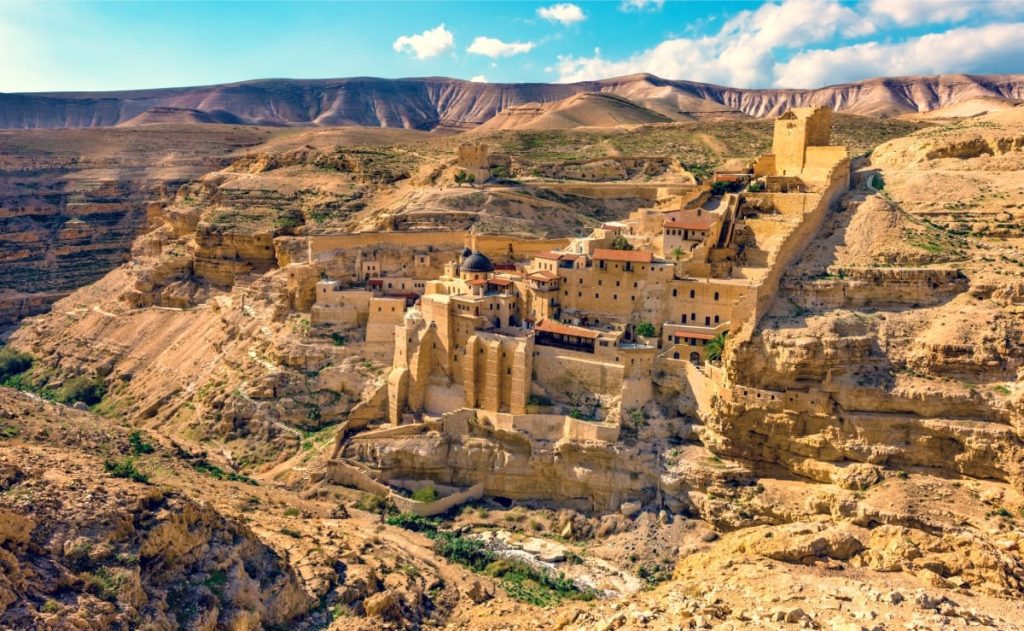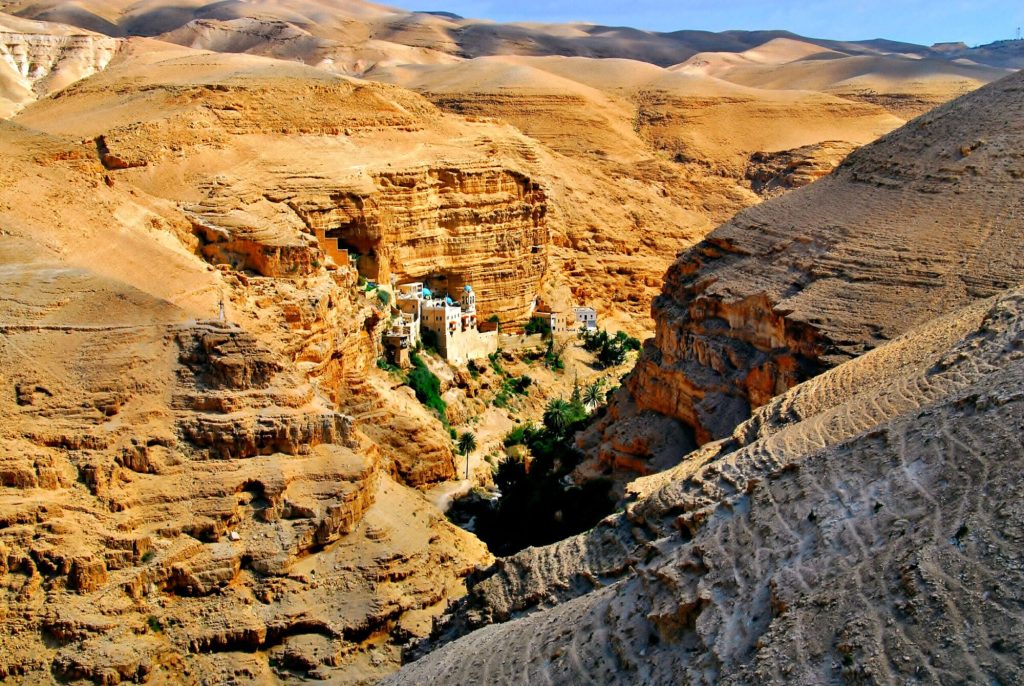Monasticism, a tradition of disciplined and ascetic living devoted to spiritual growth, has a deep-rooted history in the Holy Land, encompassing a tapestry of religious, cultural, and social influences. This overview delves into the evolution of monasticism within this sacred region, tracing its development through the centuries.
Monasteries in Israel

Early Foundations: 4th Century CE
First, the origins of monasticism in the Holy Land can be traced to the 4th century CE, a pivotal period that witnessed the spread of Christianity throughout the Roman Empire. Furthermore, pilgrims flocked to the sites associated with Jesus Christ’s life, spurring the establishment of monastic communities near these holy places. One of the most notable figures during this era was Saint Anthony of Egypt, whose ascetic lifestyle in the desert inspired numerous followers.
Faran Monastery
Desert Fathers and Mothers: 4th-6th Centuries
The arid landscapes of the Holy Land, particularly the Judean Desert, became havens for hermits seeking solitude and spiritual reflection. Known as the “Desert Fathers and Mothers,” these early monastics retreated to remote locations, living in caves and engaging in intense prayer and self-discipline. Their teachings and wisdom contributed significantly to forming Christian monasticism’s core principles.
Judean Desert Ultimate Guide

The Influence of Saint Jerome: 4th-5th Centuries
Saint Jerome, a scholar, and theologian, settled in Bethlehem during the late 4th century. His translation of the Bible into Latin (the Vulgate) played a pivotal role in shaping Western Christianity. His presence also catalyzed the growth of monastic communities in Bethlehem and the surrounding areas.
Bethlehem Ultimate Guide

Byzantine Era: 6th-7th Centuries
During the Byzantine era, the proliferation of monasteries continued, often centered around significant religious sites. Monasticism became intricately connected with the broader religious identity of the region, fostering a culture of devotion and scholarship. However, the rise of Islam in the 7th century brought significant challenges to the Christian monastic communities.

Crusader Period: 11th-13th Centuries
The Crusader period marked a resurgence of Western Christians’ interest in the Holy Land. Monastic orders like the Benedictines, Franciscans, and Dominicans established themselves in the region, constructing grand monastic complexes and fostering pilgrimage. These orders also played a role in maintaining and administrating the holy sites.
In the Holy Land, various types of monasteries have existed throughout history, each with its unique focus, structure, and purpose. These monasteries cater to the diverse spiritual, liturgical, and practical needs of different Christian denominations and communities. Here are some of the types of monasteries that have been established in the Holy Land:

Desert Monasteries:
Inspired by the examples of the Desert Fathers and Mothers, these monasteries are often located in remote and arid regions, such as the Judean Desert. They emphasize solitude, asceticism, and contemplative prayer. These monasteries can be found in both Eastern Orthodox and Eastern Catholic traditions.
Lavra Monasteries:
A lavra is a monastic complex typically consisting of a cluster of hermitages or cells where individual monks live, along with communal spaces such as a church and refectory. This type of monastery fosters a balance between solitary reflection and communal worship.
Monasticism in the Holy Land – Coenobitic Monasteries:
A communal way of life characterizes coenobitic monasteries. Monks or nuns within these monasteries live together, share resources, and participate in communal worship, meals, and other activities. This model encourages a strong sense of community and mutual support.
Bethlehem & Jericho Tour

Monasticism in the Holy Land – Skete:
A skete is a smaller monastic settlement between a lavra and a coenobitic monastery. Moreover, Sketes often consist of a small group of monks living in individual hermitages but coming together for certain communal activities.

Byzantine monasticism in the Holy Land was shaped by the lives and teachings of several key figures who made significant contributions to the development of the monastic tradition in the region. Here are some of these key figures:
Monasticism in the Holy Land – Saint Sabas (439-532):
Also known as Mar Saba, Saint Sabas was a prominent monk and ascetic who founded the Mar Saba Monastery in the Judean Desert near Bethlehem. Moreover, He is considered one of the fathers of Byzantine monasticism and played a crucial role in establishing the distinctive coenobitic monasticism practiced in the region.
Bethlhem Holy Land Tour

Saint Euthymius the Great (377-473):
Saint Euthymius was an influential monk who established the Monastery of Saint Euthymius in the Judean Desert. Furthermore, He is known for emphasizing rigorous ascetic practices and spiritual guidance for his fellow monks. His teachings greatly impacted the development of the monastic community in the Holy Land.
Monastery of Euthymius

Saint Gerasimus of the Jordan (c. 455-475):
Saint Gerasimus is associated with the Monastery of Saint Gerasimus, located near the Jordan River. He is known for his austere, ascetic lifestyle and compassionate care for the sick and needy. He is considered a model of Christian charity and humility.
Monastery of Saint Gerasimus

Saint John of Hesychast (c. 454-558):
So John the Hesychast was an early ascetic who lived in solitude near Bethlehem’s desert. Furthermore, He is credited with inspiring the establishment of several monastic communities in the region, including the Monastery of Martyrius.
Old City Jerusalem Tour

Credit: Dr. Avishai Teicher Pikiwiki Israel, CC BY 2.5, via Wikimedia Commons
Saint Chariton the Confessor (c. 3rd century):
Saint Chariton was an early Christian monk who founded the Monastery of Saint Chariton in the Judean Desert. He is known for his steadfast commitment to the monastic life and his efforts to provide hospitality to pilgrims.
Saint George of Choziba (6th century):
Saint George was a monk and hermit who resided near Jericho in the Monastery of Saint George of Choziba. He is known for his humility, asceticism, and his role in the spiritual guidance of others.

Monasticism in the Holy Land – Conclusions:
So, these key figures not only established monastic communities but also left behind writings, teachings, and examples that continue to influence the practice of monasticism in the Holy Land and beyond. Furthermore, their lives and legacies are integral to the region’s history and spirituality of Byzantine monasticism.
Today, the Holy Land remains a vibrant hub of monastic activity, with various orders representing different Christian denominations contributing to the region’s spiritual tapestry. Last, the legacy of monasticism is a testament to the enduring quest for spiritual enlightenment within this sacred landscape.

